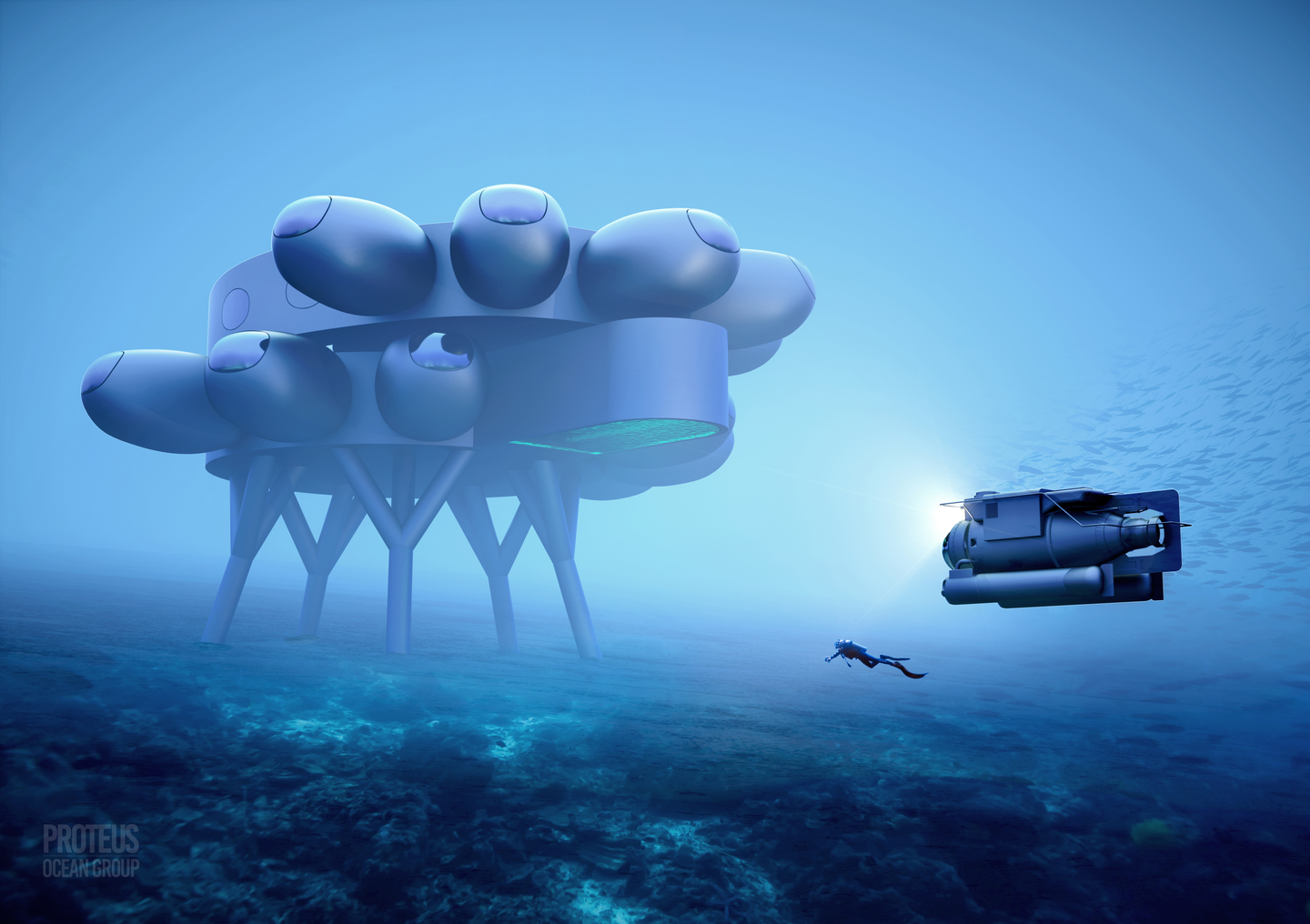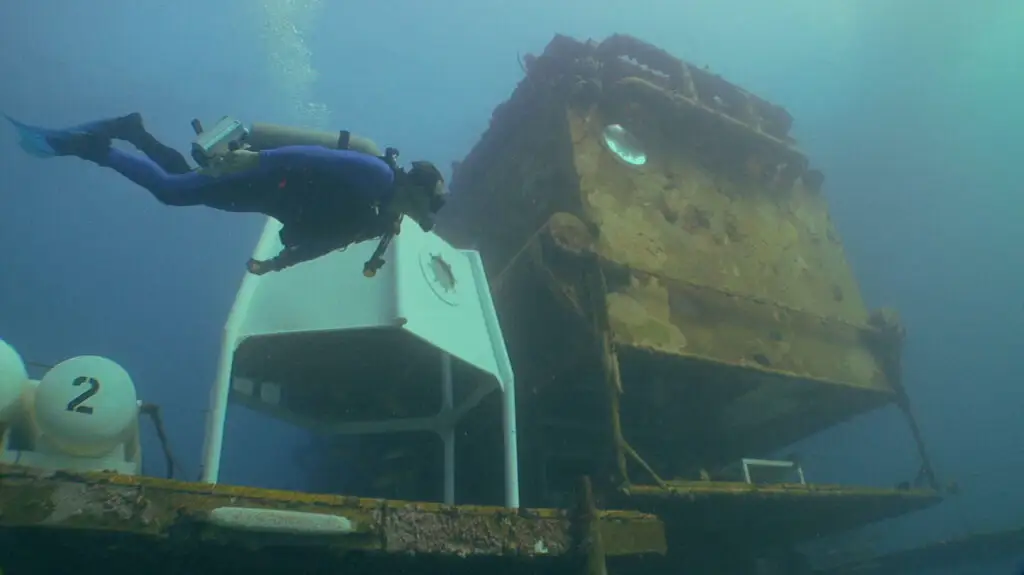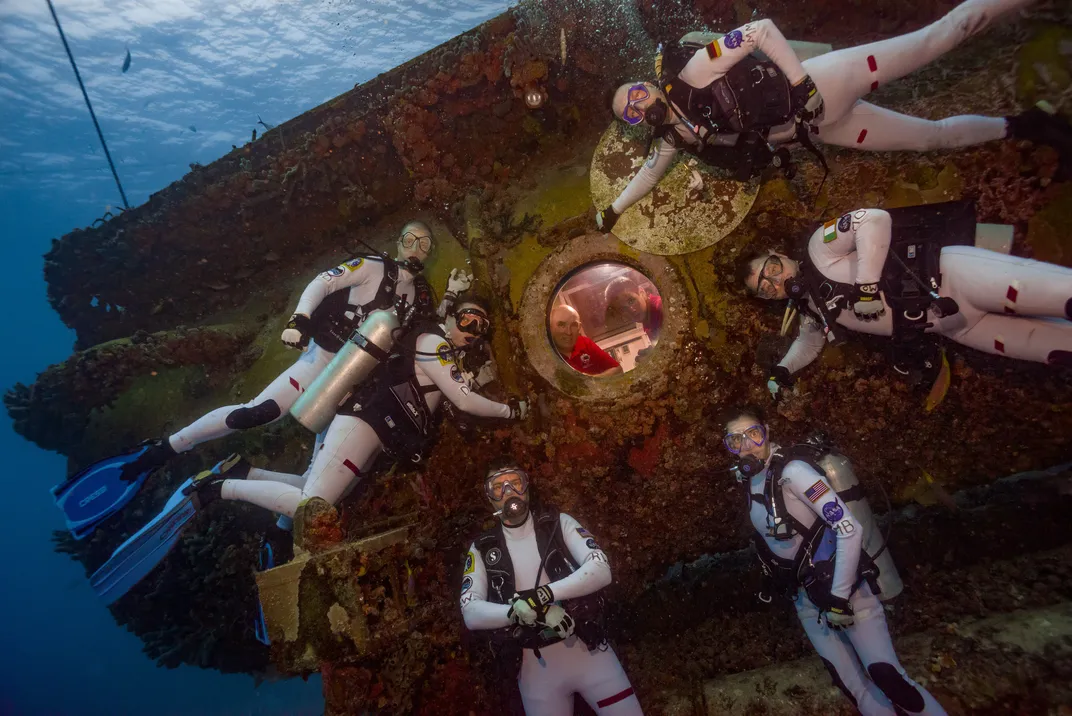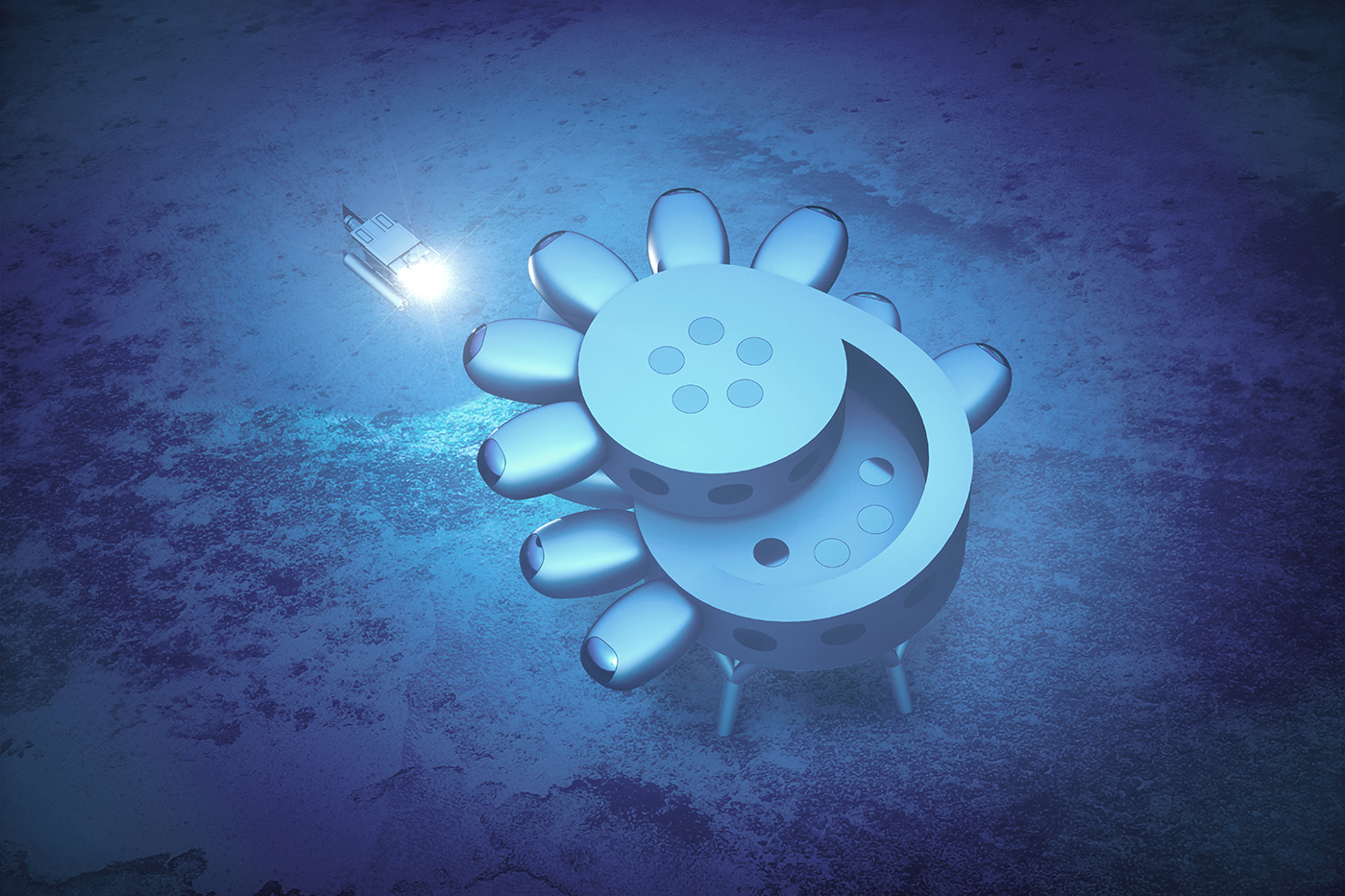The first station will be off the coast of Curaçao, and it’s scheduled to be completed by 2025.

Fabien Cousteau’s PROTEUS™. Concept designs by Yves Béhar and fuseproject.
Fabien Cousteau has a vision for how humans can live and work in the ocean. He imagines that long-term stays under the waves could be enabled through the construction of underwater habitats, which would look and feel like houses, as opposed to just sealed, submarine-like bubbles.
These habitats would have a galley, kitchen, workspace, and sleeping quarters, he describes. And of course, there would be windows, or viewports, to the outside world, and a front door in the form of a moon pool that will actually be on the bottom of the house. This would allow easy access into and out of the facility.
The project, called Proteus, would be a marine analog to the International Space Station, and would primarily accommodate aquanauts, the equivalent of an astronaut in the ocean. It’s an idea that has been bubbling for some time now. But it could start taking shape relatively soon. Proteus Ocean Group, a private company which would operate and run Proteus, has recently signed an engineering, procurement, and construction (EPC) contract with a firm that has expertise in creating hyperbaric and pressure vessels in the ocean environment. Much of what Proteus is doing in terms of the technology they’re exploring is similar to space technology.
The first unit will be installed off of Curaçao, an island north of Venezuela, in a marine protected area around 60 feet deep. The team is looking into additional locations across Europe and the US for future stations— their goal is to create a network of them. They’ve already completed 3D mapping of the seafloor around the general area where Proteus will be located.
“We did our 3D benthic mapping, which was not a small feat during COVID. We already shared the maps with Carmabi and the government of Curaçao,” Cousteau, the grandson of ocean explorer Jacques Cousteau, says. They will start their front-end engineering design phase in April and pre-construct the parts either at the end of 2022 or in early 2023. If everything goes as scheduled, Proteus, along with a connected deeper water satellite station, is expected to be installed underwater by the end of 2025. A land-based mission control station will be built in parallel.
To appreciate how a facility like this could be helpful for the researchers that might one day live there, it helps to understand what separates it from traditional ocean technology, like a sub. “It’s very different from a submarine. A submarine is a bubble. Proteus and the deeper water station will not technically be pressure vessels,” Cousteau says. “The ambient pressure inside will be the same as the pressure outside. A pressure vessel is when you have a differential in pressure inside versus outside.”
He compares it to taking a cup, inverting it, and pushing it down into water. An air bubble would form inside, and water doesn’t go into the bubble because the pressures inside and outside the cup are at equilibrium. This would be useful for the explorers who live there because they don’t need to adjust and readjust to differing pressures inside and outside Proteus when leaving it to SCUBA dive.
What Proteus proposes is not a new idea. In fact, Cousteau’s grandfather was one of the early pioneers of underwater habitats in the 1960s. The History of Diving Museum estimates that over 60 seafloor habitats have been constructed, although most have been abandoned or have fallen to disrepair. The last standing one is Aquarius, located in the Florida Keys at a depth of 60 feet, which is still used to train astronauts and host research missions. In 2014, Fabien Cousteau stayed for 31 days at the reef base station, and shared an inside view of life under the waves with PopSci.
Some specs on the last remaining underwater research station
Originally, Aquarius was a joint project between NOAA and the US Navy. But since it was put in place in 1986, it has been passed to Florida International University. Aquarius consists of a three-part system: a habitat containing the lab and living spaces, a life-support buoy that relays air and communications from the habitat to the shore, and 120-ton base plate that weighs the habitat down on the seafloor. Beyond its scientific instruments, the lab has networked computers, internet, phones, radios, and video-conferencing equipment.

The Aquarius Reef Base. NOAA’s National Ocean Service/Flickr
“An underwater lab gives us the ability to stay underwater for extended periods of time,” says Cousteau. That allows researchers to collect data around-the-clock. Plus, he adds, “You learn to saturate.”
A regular scuba diver descending to a depth of 60 feet can only stay underwater for an hour or so. Because rapid changes in pressure can cause dissolved gases in the body to form expanding bubbles that can obstruct blood flow or cause other medical issues, if they come up too quickly, it can cause what’s known as the Bends. This is also why divers have to wait up to a day after their last dive before they can get on a flight.
Saturation at depth allows the body to acclimate to the multiple atmospheres of pressure (60 feet corresponds to three atmospheres of pressure, or three times the pressure at the surface, and denizens of the facility would feel this new pressure all the time) and stay underwater for longer periods of time. When divers are ready to come up, they undergo a decompression process where the pressure around them is gradually brought back to the pressure on land so the gases can safely leave their body.
[Related: Fish sounds tell us about underwater reefs—but we need better tech to really listen]
“We dove 8 to 12 hours a day per person during the [2014 mission on Aquarius] because of the gift of time at the bottom of the sea,” Cousteau says. “We were able to do three years worth of scientific research in 31 days as opposed to a ship stationed at the surface with divers coming down.”

Astronauts training at Aquarius Reef Base. NASA’s Marshall Space Flight Center/Flickr
But Aquarius is 35 years old. “It’s a dinosaur. And it’s very limited in space,” Cousteau says. “I joke with fellow New Yorkers that it’s like living in a studio apartment with five roommates.” The interior of Aquarius totals 400 sq ft and the capacity is 6 occupants. He is planning for Proteus to be around 4,000 sq ft, with room to accommodate around 12 residents.
Cousteau wants to add some new features too, like a submarine docking station or hangar, “akin to someone’s garage with a car, so that we can use that tool to go to places that are not pragmatic as aquanauts,” he says. The garage could also be used to deploy autonomous underwater vehicles that go out and collect data around the Caribbean. Then, they can come back to Proteus to get serviced and have their data downloaded.
The plan for Proteus
Like the ISS, Proteus would be modular, Cousteau hopes, which means that it could be taken apart like a Lego set and reassembled with upgraded tech components as time goes on. (Although unlike the ISS, it would not be a sealed facility.)
“We will be able to keep up with future demands, with technologies that continue to evolve,” Cousteau says. “You can continue to upgrade the internal infrastructure as well as some of the external superstructures.”
Curaçao is on a seamount. The underwater topography has an average slope of 45 degrees. If the location is just right, it could offer Proteus easy access to a wide range of ecosystems, spanning from coral reefs to the top of the twilight zone. “We want a place that’s conducive to research but engineering-wise, is not too complicated. And we want to be in close proximity to where mission control will be,” says Cousteau. “We are working with the government of Curaçao and Carmabi, the manager of the marine protected area, to be able to pinpoint the location.”
The main components will borrow from proven technologies of habitats past. There will be wet labs, pressurized decompression chambers (to prepare aquanauts for resurfacing), a broadcast studio, a hydroponic garden, a larger sleeping space, and an umbilical connecting Proteus to a mission control station on land and to a deeper satellite habitat, located at around 230 feet below the surface.
The satellite habitat will be a heliox environment, meaning that the breathing gas is a mixture of helium and oxygen. Divers need special training for those conditions, and Cousteau will prepare higher-performing diving equipment and a heating system for that habitat. “For special missions, that will be available to smaller groups to do [a] much deeper kind of research,” Cousteau says. “Bear in mind if you’re saturated at 3 [atmospheres of pressure], you’re able to go down to 70 meters for 2 hours without any decompression obligations before going back to Proteus.”
The mission control facility on land will house infrastructure such as dry laboratories and health assessment rooms, and the umbilical to Proteus that can directly provide 16k broadcast capabilities, plus power, the cooling system, life support, fresh water, and breathing air. As a backup, Proteus will have secondary systems underwater that can sustain it for a few weeks in case the umbilical gets severed. Mission control will be able to provide the surface support, through boats, AUVs and submarines, that shuttle back and forth between land and Proteus.
Another key issue is food and other amenities. Chemistry works differently at three atmospheres. Even soap can be toxic at that pressure, he says. Add that to the fact that because there’s oxygen in the breathing air under pressure, there can’t be open flames for cooking or any other heat source that can ignite. This is where Proteus can borrow innovations and solutions from space technology.
Proteus will house a range of diving equipment that can allow for researchers to carry out experiments like selective breeding of families of corals, observing climate-change-related issues or weather patterns, deploying sensor arrays to count microplastic concentrations in the water column in real-time, examining a new species, or analyzing the chemical compositions of samples on site—all in the underwater lab without having to transport it long distances.

A rendering of Proteus. Concept designs by Yves Béhar and fuseproject. Concept designs by Yves Béhar and fuseproject
Cousteau is aiming for Proteus to be powered by renewable energy. “I’d love to be able to look at other sources of baseline energy generation [outside of wind and solar],” he notes. “For example, ocean thermal energy conversion, which is a proven technology but hasn’t been implemented in any large format.”
Mirjam Fürth, a professor of ocean engineering at Texas A&M University, has no doubt that Proteus will be able to do what it proposes by the time it gets its finances sorted. (It won’t be cheap: Forbes puts the price for building Proteus at $135 million. Proteus receives private funding as well as funding from Fabien Cousteau’s nonprofit, The Fabien Cousteau Ocean Learning Center).
But she points out that there might be certain technical challenges that come with scaling up that still need to be stress-tested. This issue boils down to the simple question around how they plan to get things in and out of their underwater home. For example, the submarine that they’re planning, is it supposed to enter through a giant moon pool or via an airlock? And how are food and other supplies going to be delivered for occupants?
“I think that’s why we haven’t seen [underwater habitats] at a large scale. Because a lot of these things are not linear when you scale up the complexity,” Fürth says. “Building something at a 60-feet depth is not complex, but having a large group of people living there for a prolonged period of time, some of which may not be experts—that’s what we haven’t seen before and that’s the hard thing that they’re going to need to tackle.”
The other factors that need to be considered include possible damage from hurricanes and underwater seismic activity, she adds. (Aquarius’ life support buoy was damaged by Hurricane Irma in 2017). Having an umbilical, as opposed to a buoy, could be “a lot safer in rough weather,” she says, though it might be more expensive.
However, despite these considerations, Fürth thinks that the materials and the technology that can enable Proteus to take form have been available for a while now. And it’s not the only company interested in such a project. A separate project, called SeaOrbital, has also been working on a floating spaceship lab in the ocean. The main hurdle for these ventures has been cost.
“That’s why I think it’s happening now,” she says, when they can capitalize on this new age of exploration and the rise of the blue economy. The “blue economy” is a term that encapsulates the growing interest in aquaculture (seaweed, shellfish, and more), wave energy and wind energy converters, and tech for desalination.
“The technology for robots has definitely leaped in the last decade and definitely in the last couple of years for marine applications,” she adds. “And the cost has come down significantly.”
“This drive of the blue economy has made people realize that there might be something here other than traditional fishing. I think this is part of it,” Fürth says. And in this new age of exploration, visiting a foreign world under the sea, rather than in space, “is something that is more attainable for people.”





